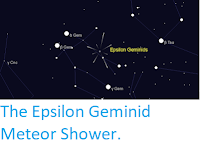The Leonis Minorid Meteor Shower is visible between 14 and 27 October
each year, with peak activity due on the night of Thursday 24 October
2019, when 1-2 meteors per hour may be visible in the Northern Hemisphere. The shower takes its
name from the constellation of Leo Minor (to the north of Leo), from which the meteors appear to
radiate. The Leonis Minorid Meteor Shower is generally easier to spot
in the Northern Hemisphere than the Southern, though it is possible to
see the meteors from anywhere on Earth. Although the number of meteors is low, the individual meteors tend to be quite bright, which, combined with the fact that the shower will peak after the Last Quater Moon on 21 October, should make for a reasonable chance of seeing a meteor for anyone with the patience, with optimum viewing accruing just before dawn.
The Radiant Point of the Leonis Minorid Meteors. Modified from Dominic Ford/Map of the Constelations/In The Sky.
Meteor streams are thought to come from dust shed by comets as they come
close to the Sun and their icy surfaces begin to evaporate away.
Although the dust is separated from the comet, it continues to orbit the
Sun on roughly the same orbital path, creating a visible meteor shower
when the Earth crosses that path, and flecks of dust burn in the upper
atmosphere, due to friction with the atmosphere.The Leonis Minorid Meteor Shower is caused by the Earth passing through the trail of the Comet C/1739 K1, and encountering dust from the trail of this comet.
The dust particles strike the atmosphere at speeds of about 223 200 km
per hour, burning up in the upper atmosphere and producing a light show
in the process.
The orbital trajectory and current position of C/1739 K1. JPL Small Body Database.
Comet C/1739 K1 was discovered on 28 May 1739 by Italian
astronomer Eustachio Zanotti. Its name implies that it was the first comet
discovered in the second half of May 1739 (period 1739 K). Unlike most comets it does not have the name of its discoverer appended to the end of the name, as this convention had not been invented in 1739.
C/1739 K1 is a Parabolic Comet, which is to say a comet that was disrupted from an orbit in the Oort Cloud, and passed through the Inner Solar System on a parabolic orbit that will probably not bring it back again. This parabolic trajectory tilted at an angle of 124° to the plain of the Solar System, that brought it in to 0.67 AU from the Sun at perihelion (i.e. 0.67 times as far from the Sun as the planet Earth, slightly inside the orbit of the planet Venus) in 1739. It is now 240 AU from the Sun, eight times as far as the planet Neptune, considerably beyond the Kuiper Belt (which extends to about 50 AU from the Sun), but still not as far as the Oort Cloud (which starts at about 2000 AU from the Sun).
See also...
Follow Sciency Thoughts on Facebook.








